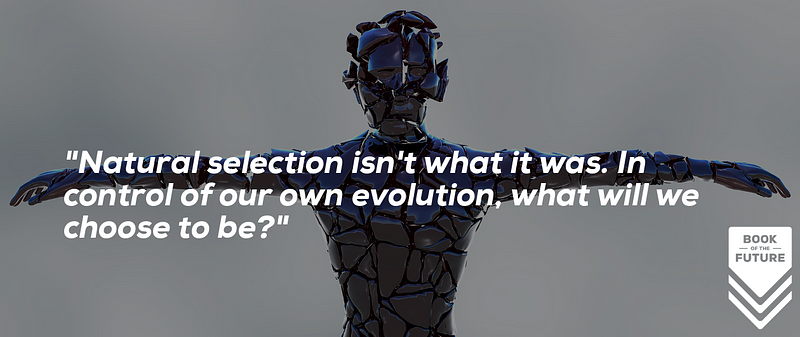Three Things I Want from Engineered Evolution

At the How To Change the World conference this week we heard from a range of speakers who talked in one way or another about the control we will soon have over our own physical development. It included the application of stem cells and other techniques in the regeneration of human tissue and organs — even to defeat ageing. And the use of psychedelic drugs to consciously expand our own thinking and change our brain plasticity to enhance learning. The options are many.
Whether through biology or technology — and frankly the boundaries between the two are blurry, given the importance of quantum physics in both — we are now in control of our own evolution. Natural selection is no longer the force it was. What traits we want to select, we have to choose, or even design. At the conference, Professor Julian Savulescu termed this ‘evolution under reason’, but you could equally call it ‘rational selection’ or ‘engineered evolution’.
This throws up a number of ethical dilemmas, particularly around the prospects for inequality, as today’s debate around gene editing is highlighting.
Assuming we can address those to the satisfaction of most — at least the rational portion — the prospects are rather exciting.
I’ve always been rather squeamish about human modification. Tattoos and piercings are not for me. And no, I’m not interested in the spam adverts for other forms of male enhancement. But there are certainly aspects of my abilities over which I would like greater control. Particularly the mental ones.
Here are three examples that are top of my wishlist.
Focus
Like most people there are particular times of the day when I am at my best. The exact hours change between summer and winter but it’s always first thing in the morning. It’s not always possible, or desirable to be at my desk by 7. And if I miss my window, which may only be three or four hours at most, then my day can be deeply unproductive. I might still plough through some expenses or achieve the rare feat of clearing my inbox, but I likely won’t create anything, and that’s largely what I get paid for.
There are other periods in the day when I get bursts of creativity, but these are less predictable. Even the usual methods of seeking distraction, or inspiration, or just letting my brain freewheel on a walk, often don’t give me more than a few minutes of renewed focus.
But what if I could turn this mind state on and off. With a switch or a pill? What could I achieve then?
There are a few options here today for this. I could try drugs like Adderall and Ritalin, but these are both illegal without prescription and have serious potential side effects. Similar drugs pop up as ‘legal highs’ but these carry all the same risks and more. If I were going to pop a pill I’d want it to be very well tested and regulated.
I could also try Transcranial Direct Current Stimulation or tDCS, an increasing popular alternative to drugs for DIY brain hackers. But again the science on this is in its early days. While there are enthusiastic proponents, my natural scepticism leads me to want some solid trials before I start to experiment.
The answers aren’t there yet, but there are clear opportunities.
More RAM
Computers have a neat way to deal with a shortage of short-term memory. They dump a chunk of it into long-term memory and then retrieve it when it’s needed.
Humans do something similar. Some can do this with their own minds, with pretty reliable recall. I am not one of those people. Instead I rely on tools: notebooks, apps, my calendar, photos.
I once tried to replicate the computer’s process more precisely. I maintained what I grandly called a ‘livepad’. A single cloud-stored document, always open, on which I could record notes, ideas, my todo list, unfinished blog posts. It worked for a while but my limited interface to it (the keyboard), unreliable connectivity, and simple lack of discipline meant that I dropped it after a while.
Imagine something similar, with a better interface, and a level of intelligence to it. A place where you could record ideas that could be replayed back to you at the right time. The added intelligence in the pad may even help you to find coherence and commonality in those ideas, as well as assisting you with more mundane tasks, like remembering where to be and when.
High Bandwidth Interface
I think in words, more than pictures. Language is my preferred interface, and the way that I record and share language most frequently is via the keyboard.
The keyboard has proven to have incredible longevity. It is perhaps three hundred years old, based on the earliest patents. But it has limitations. I can only communicate words with it (for the most part). It is not that fast — certainly not in my hands.
I could try to learn to touch type, but even then I am limited to a relatively cumbersome interface. I can’t capture my thoughts on the move (though I do a decent job of writing blogs with my thumb while travelling on packed Tube trains). I could use a voice interface, but this isn’t exactly private and could be very annoying for those around me: I talk loud.
Instead I want the words to flow straight from my brain to the page, or the storage system.
This is some way off unfortunately. Though we are reaching the point where we can control artificial limbs with thoughts, the understanding of the brain on which this incredible achievement is based remains limited. For all our comprehension it is still largely a black box to us.
Evolution in Our Control
These are examples of what we might be able to add to human physiology in the years ahead. Even the drugs could be added to new glands as they are in Iain M Banks’ Culture novels. But they are elective and trivial compared to some of the choices we will have to make soon. We will have the capability to eliminate some genetically-carried diseases by selectively editing people’s genomes.
With that sort of power in our hands, we all need to think about the implications*.
###
* If you want to make a start, you could do worse than to watch this video from Professor Julian Savulescu:
